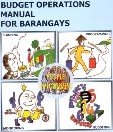 Sorry for the four-day hiatus. I've just been back from a three-day trainers' training in Cebu City, the other "Queen City of the South" (Iloilo City is the other and the original) - along with four other staff: Edge, Eme, Liane and Lynnie. Of course, we're not the only participants. Our counterparts in Regions 7 and 8 as well those from the five ROs in Mindanao were also around.
Sorry for the four-day hiatus. I've just been back from a three-day trainers' training in Cebu City, the other "Queen City of the South" (Iloilo City is the other and the original) - along with four other staff: Edge, Eme, Liane and Lynnie. Of course, we're not the only participants. Our counterparts in Regions 7 and 8 as well those from the five ROs in Mindanao were also around.The 3-day sojourn in Cebu was, according to Secretary (Nonoy) Andaya, who joined us on the second day - about training us to "plant a BOMB". Don't get me wrong (or the Secretary). The "BOMB" is the acronym for Budget Operations Manual for Barangays, one of the DBM's most recent publication done primarily through the intiative of DBM RO IV-B's Director Lando Garcia. Designed to be simple, easy-to-understand, and user-friendly, this new Manual will be rolled-out to the barangays comes year 2008 - in time for the new set of barangay officials, assuming the elections will go on as scheduled.
It seeks to, in the Secretary's own words, "demolish old planning concept" by prescribing clear guidelines on how to connect development plan to the budget; and "obliterate bad budgeting practices" by supplanting it instead with a policy-driven, performance-based and participative budgeting.
Quite a tall order and sounds like we're really serious in reforming budget management down to the basic unit of our governance. But will it work for the barangays? That will be our formidable task - us DBM trainers. But we're not alone in this endeavor. Our other attendant task is to train regional trainers in every city and municipality composed of local finance committee members (budget officer, planning and development coordinator, treasurer) and accountants. We're expected to carry out the regional training by January next year.
There were several other revelations the Secretary mentioned during our dialogue with him. I'll post this in the days to come. Abangan . . .




